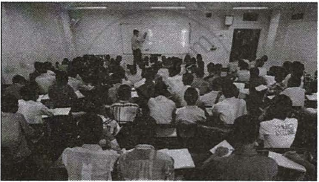Advertisements
Advertisements
Question
A man invested an amount at 10% per annum simple interest and another amount at 10% per annum simple interest. He received an annual interest of Rs. 1350. But, if he had interchanged the amounts invested, he would have received Rs. 45 less. What amounts did he invest at different rates?
Solution
Let the amounts invested at 10% and 8% be Rs.x and Rs.y respectively.
Then as per the question
`(x × 10 × 1)/100 =( y × 8 × 1)/100 = 13/50`
10x + 8y = 135000 …………..(i)
After the amounts interchanged but the rate being the same, we have
`(x × 8 × 1)/100 =( y × 10 × 1)/100 = 1350 – 45`
8x + 10y = 130500 …………….(ii)
Adding (i) and (ii) and dividing by 9, we get
2x + 2y = 29500 ……………(iii)
Subtracting (ii) from (i), we get
2x – 2y = 4500
Now, adding (iii) and (iv), we have
4x = 34000
`x = 34000/4 = 8500`
Putting x = 8500 in (iii), we get
2 × 8500 + 2y = 29500
2y = 29500 – 17000 = 12500
y = `12500/2 = 6250`
Hence, the amounts invested are Rs. 8,500 at 10% and Rs. 6,250 at 8%.
APPEARS IN
RELATED QUESTIONS
Find the value of k for which the following system of equations has a unique solution:
kx + 3y = 3
12x + ky = 6
Solve for x and y:
`x/3 + y/4 = 11, (5x)/6 - y/3 + 7 = 0`
Solve for x and y:
`3/x - 1/y + 9 = 0, 2/x + 3/y = 5`
Solve for x and y:
6(ax + by) = 3a + 2b,
6(bx – ay) = 3b – 2a
Find the value of k for which the system of equations has a unique solution:
kx + 3y = (k – 3),
12x + ky = k
For what value of k, the system of equations
kx + 2y = 5,
3x - 4y = 10
has (i) a unique solution, (ii) no solution?
A number consists of two digits. When it is divided by the sum of its digits, the quotient is 6 with no remainder. When the number is diminished by 9, the digits are reversed. Find the number.
Find the value of k for which the following pair of linear equations has infinitely many solutions.
2x + 3y = 7, (k +1) x+ (2k -1) y = 4k + 1
The value of c for which the pair of equations cx – y = 2 and 6x – 2y = 3 will have infinitely many solutions is ______.
Read the following passage:
|
A coaching institute of Mathematics conducts classes in two batches I and II and fees for rich and poor children are different. In batch I, there are 20 poor and 5 rich children, whereas in batch II, there are 5 poor and 25 rich children. The total monthly collection of fees from batch I is ₹9,000 and from batch II is ₹26,000. Assume that each poor child pays ₹x per month and each rich child pays ₹y per month.
|
Based on the above information, answer the following questions:
- Represent the information given above in terms of x and y.
- Find the monthly fee paid by a poor child.
OR
Find the difference in the monthly fee paid by a poor child and a rich child. - If there are 10 poor and 20 rich children in batch II, what is the total monthly collection of fees from batch II?

